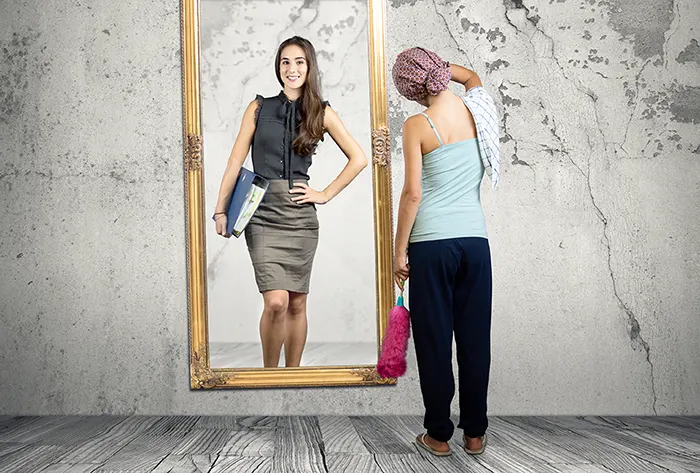The self refers to an individual’s sense of being and identity. There have been a lot of theories about self. One popular and useful theory described here is the looking-glass self theory. Charles Horton Cooley introduced the concept of looking -glass self. According to him, individuals understand their selves by observing how others perceive or think of them. Social interaction has a bigger impact than we imagine.

Source: Xenia-Luise/Adobe Stock
The looking-glass self uses a mirror as a metaphor for how we view others’ perceptions to understand ourselves and base our worth. According to Cooley, the looking glass self indicates that how one sees oneself is not an individual phenomenon, but rather involves others. He admits that society and individuals are not so distinct, they are related and distributive factors of the same thing.
Steps of Looking-Glass Self Theory
The looking glass-self theory works through the following steps:
- A person in a social setting imagines or thinks about how they occur to other people.
- Then, the person imagines how others perceive them.
- Eventually, the person has feelings about their evaluation, and he/she reacts to it.
For example, Tina gets an invite to a high-class social gathering. She gets ready in her best clothes and feels confident in her looks. She attempts to express this confidence appropriately. Positive reactions to this attempt will enhance her self-confidence. Negative reactions to this attempt could make her feel less confident in herself.
Social Media and Looking-Glass Self
Social networking sites provide more complexity to the looking-glass self. Now, individuals are exposed to multiple perceptions and judgements of others. It is like having multiple mirrors. Social media has introduced the cyber self. The cyber self refers to the image an individual wants to create for him/her on social networking sites. The individual can connect with others, receive feedback, and engage in social norms on these social networking sites.
There are differences in the actual self and the cyber self. For example, there can be multiple cyber selves. There can be a professional self (displaying resumes and skills) on LinkedIn, an opinionated self on Twitter, a photogenic self on Instagram, etc. The cyber self is constantly exposed to evaluation and judgement and is far more prone to being shaped and updated according to the perceptions of people on these sites.
There can be a lot of negative effects on the cyber self. Individuals may invest more time, energy, and resources to develop their cyber presence on multiple sites, rather than investing in their actual selves. Individuals can also face bullying or shaming on social media due to their cyber identities. Young teens can face confusion in identity or developmental issues.
However, not all effects of cyber self are negative. This fact will be illustrated in the following study.
Study
By: Julie M. Jones
Aim: To investigate self-concept changes due to social media.
Method:
- 102 YouTube producers voluntarily participated in this study.
- They were interviewed about their content creation and asked if those creations have had any effects on their sense of self.
Results:
- The results indicated a range of positive changes, such as gained confidence, creativity increased, sense of self-worth increased.
- They also felt a sense of altruism, as they believed they were helping people through their content.
- They indicated overcoming social struggles and developing a strong professional image through social media.
Criticisms of Looking-Glass Self Theory
- The looking-glass self theory invalidates the impact of in-group and out-groups. In group refers to the people who know the individual closely, it could be close family and friends. Outgroup refers to people who the individual does not identify with or is not very close. It could be distant relatives, acquaintances, or strangers. This refers to the fact that individuals value the opinions and evaluations of their in-group (people they identify with, similar culture) more than the outgroup.
- The context and nature of people can impact the concept of looking-glass self. Signals such as body language have the potential to be misunderstood.
- Not every judgement or perception carries the same weight for an individual. He or she is more likely to believe in the evaluation of a close one instead of a stranger.
- Individuals also rely on their value systems to make judgements and decisions about themselves.
How does this theory help in self-development ?
Through looking-glass self theory, one learns to look at self from other’s perspectives. This ability is not innate, it is learned through socialization. As we grow up, we learn how to look at ourselves from another’s perspective and that helps us become more aware of ourselves, leading to the development of self.
How can one get self-confidence via this theory ?
Self-confidence can be defined as a belief in oneself. The looking-glass self theory states that humans form their beliefs through other people’s perceptions and opinions. Humans become aware and know about themselves through others.
For example, when a child does something desirable and receives positive reactions from family members, the child learns that the behaviour is good and hence, continues to engage in the same. This praise from family members could help build the child’s self-confidence.